
Question: How does a moose take a selfie?
Answer: By triggering one of our wildlife monitoring cams, of course!
Part of our work on BC highways is to help prevent animals and drivers from crossing paths and monitoring our wildlife crossings with motion activated cams is just one of the ways we do this.
We use these images to get a better understanding of how animals are using our wildlife crossing and how they interact with each other at these locations. We use this information to improve our crossings and make them useful to more animals. We’ve seen some pretty great shots on our Wildlife Monitoring Program cams, but this one takes the cake. “Hello there moose! Come here often?”
Here are some more wonderful shots we’ve found recently that we just had to share with you. Enjoy!
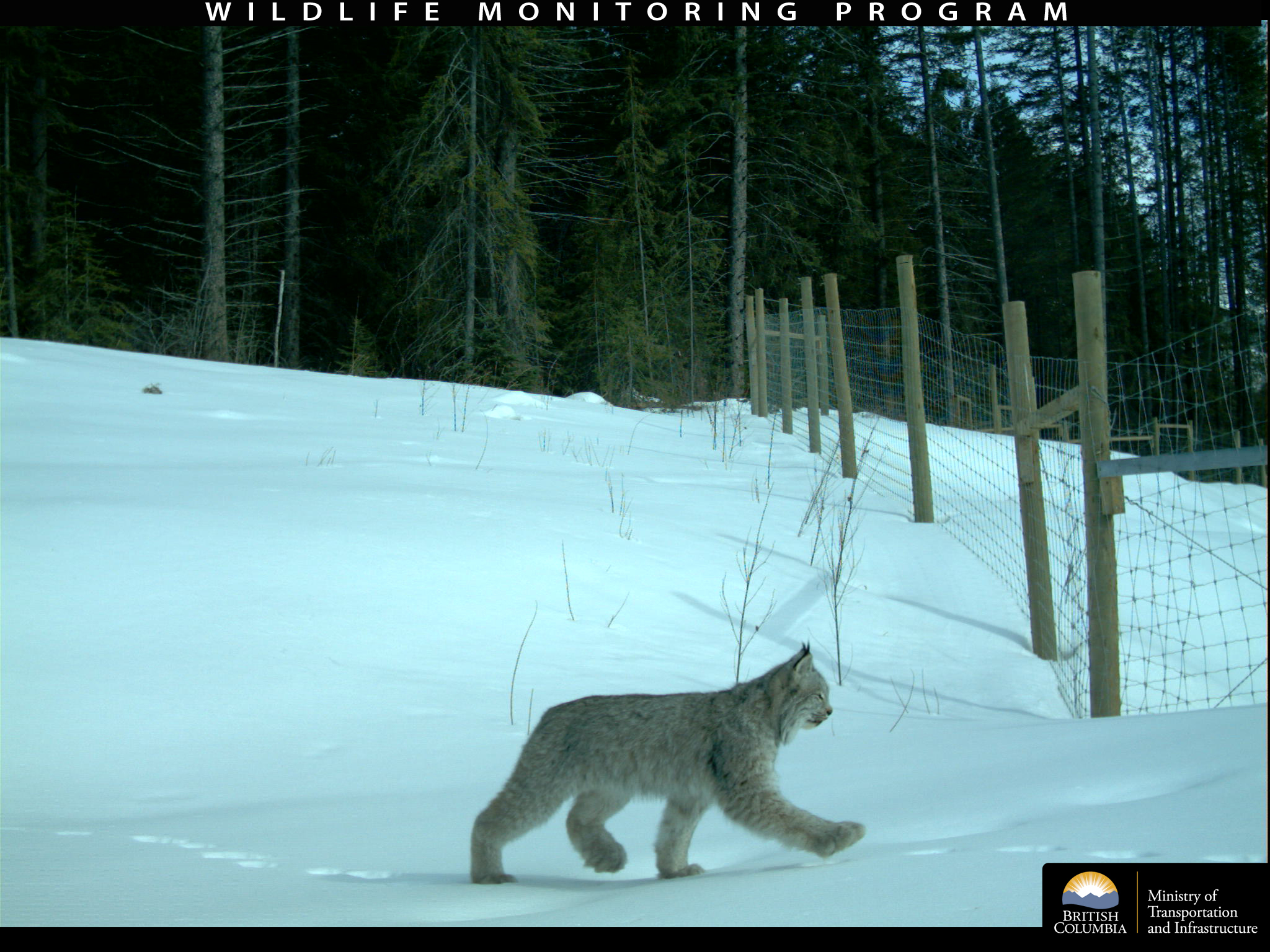
A beautiful shot of the reclusive lynx moving through a part of our wildlife fencing.
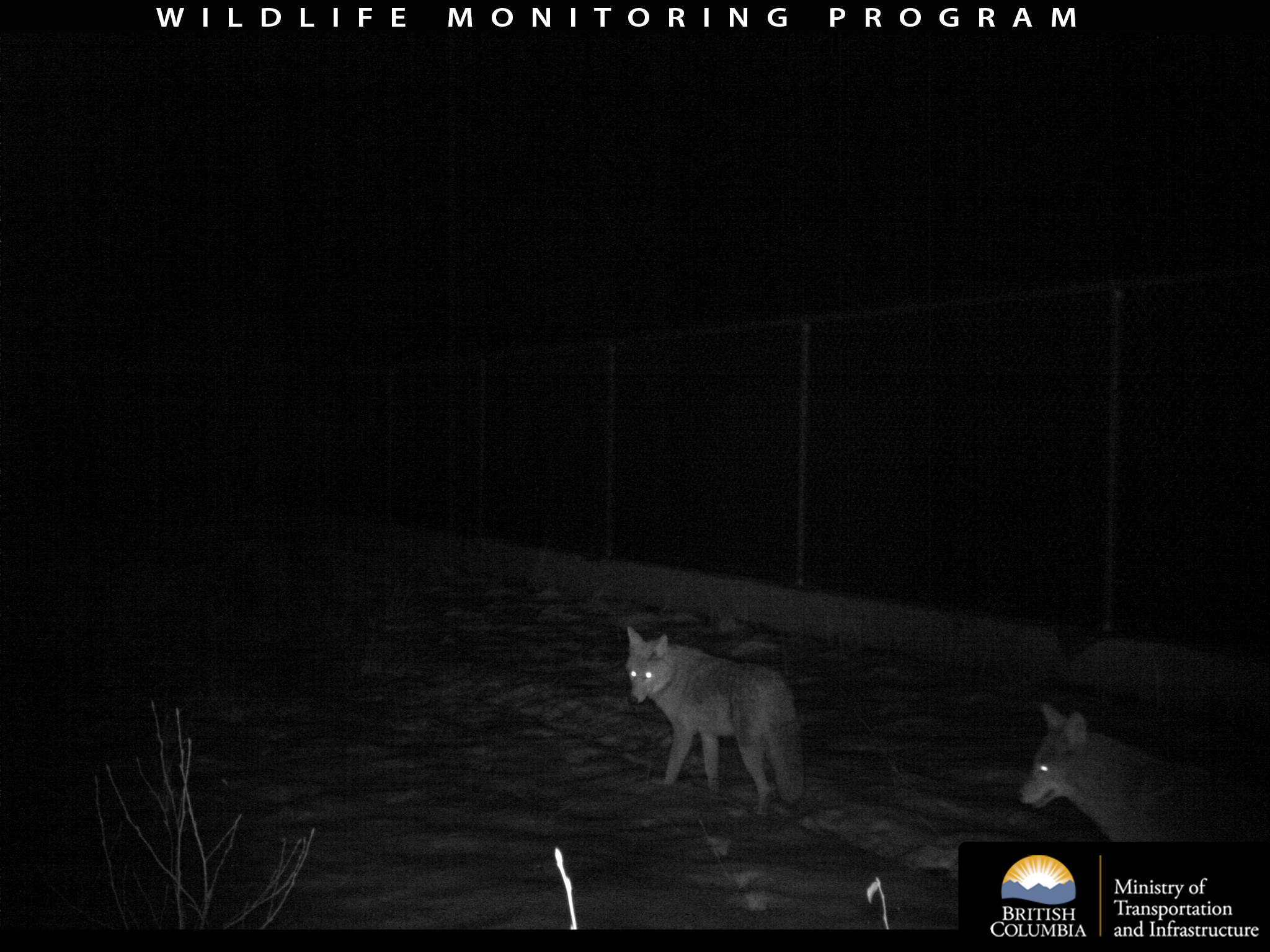 Animals use our crossings around the clock. These two coyotes triggered the camera while out on the prowl during a cold winter night.
Animals use our crossings around the clock. These two coyotes triggered the camera while out on the prowl during a cold winter night.
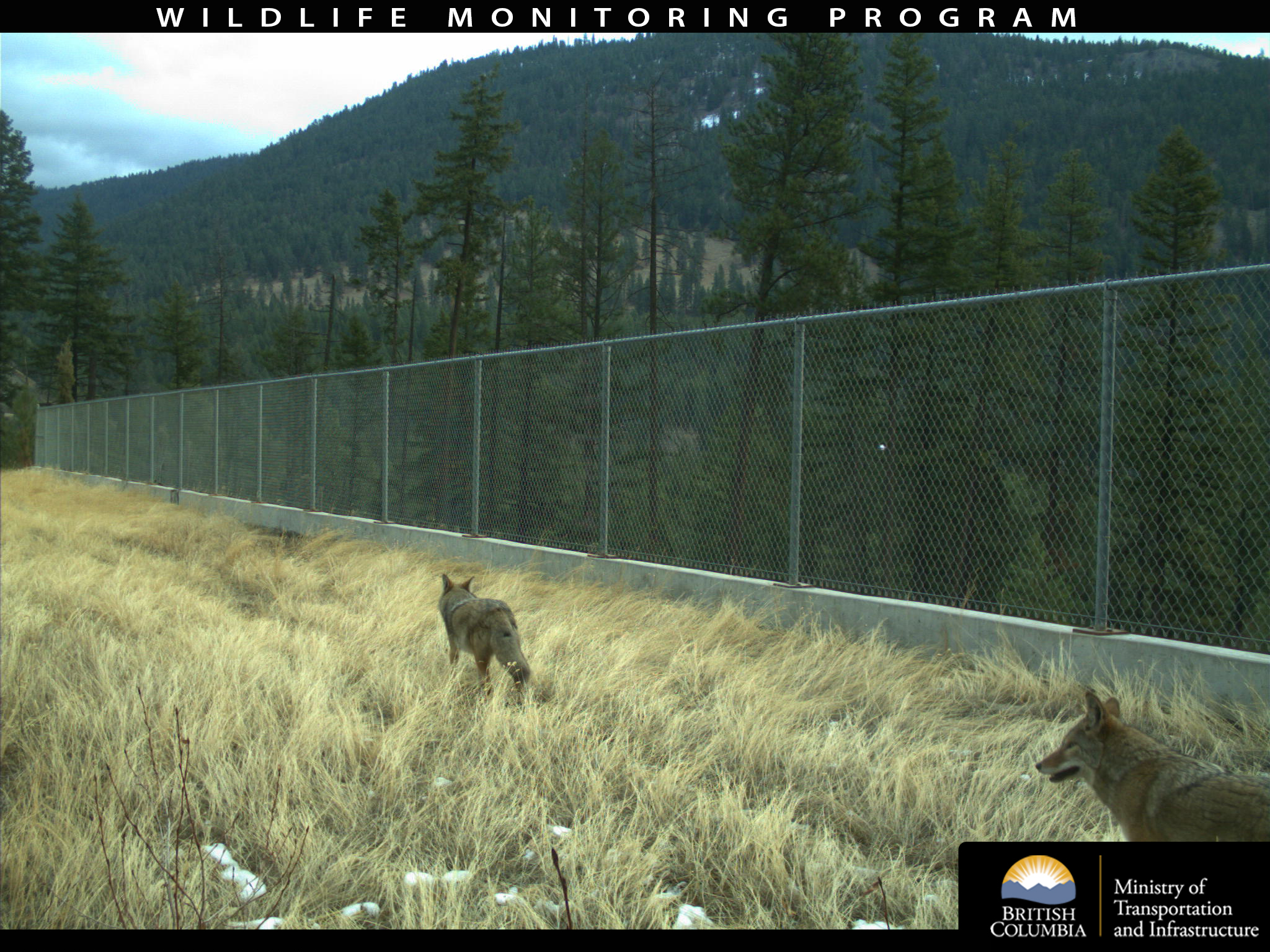 Possibly the same two coyotes, using the pass during the daytime.
Possibly the same two coyotes, using the pass during the daytime.
Wow! Watch this coyote in hot pursuit of a deer across one of our overpasses.
Our wildlife crossings are well used, but animals don’t tend to cross paths while using them, instead, they tend to pass each other “like ships in the night.” We’ve been observing these cams for years now and this is the first time we’ve ever seen anything like this.
Can’t see the video above? Try watching it directly on our YouTube channel.
 Well, heck. It doesn’t get much cuter than this little cub following Mumma bear through the underpass, does it? Cuteness factor: Squeeeeeeeeeeeeee!
Well, heck. It doesn’t get much cuter than this little cub following Mumma bear through the underpass, does it? Cuteness factor: Squeeeeeeeeeeeeee!
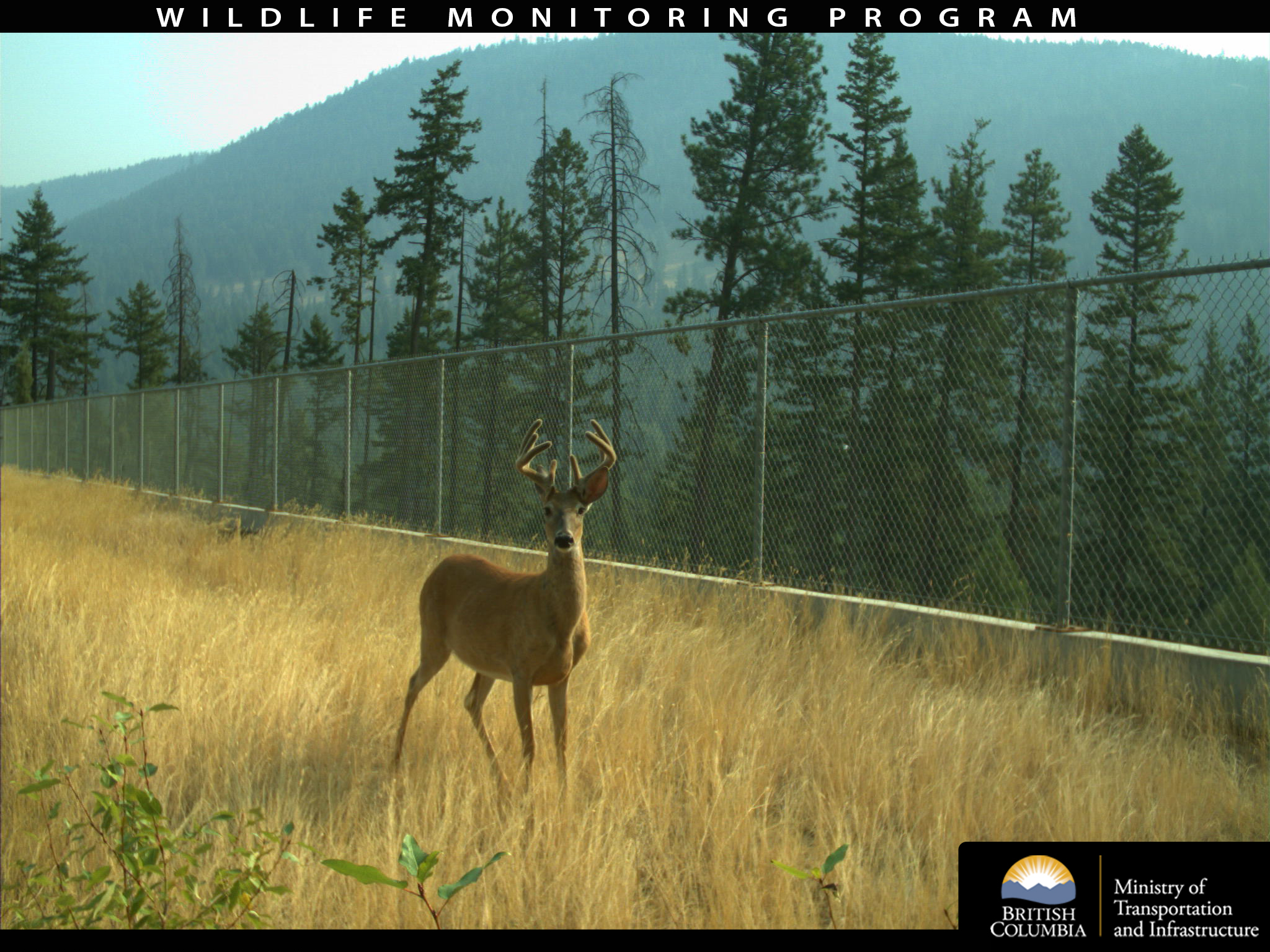 Hello Handsome! This beautiful buck (we’re calling him Buck Pitt) triggered the cam a few times as he crossed over the pass cautiously.
Hello Handsome! This beautiful buck (we’re calling him Buck Pitt) triggered the cam a few times as he crossed over the pass cautiously.
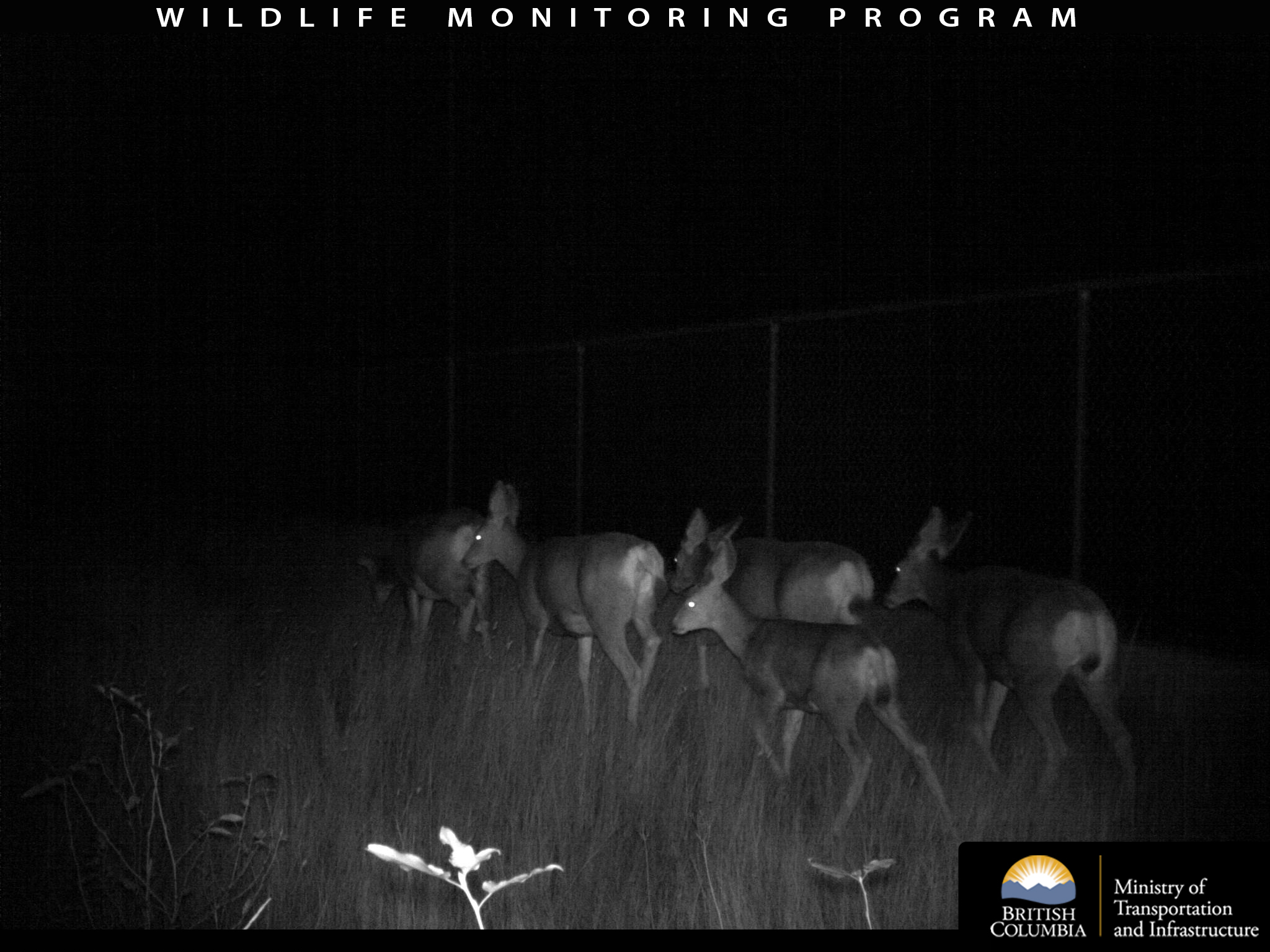 A large herd of deer move across the pass under cover of darkness, perhaps on the trail of Buck Pitt?
A large herd of deer move across the pass under cover of darkness, perhaps on the trail of Buck Pitt?
We estimate that a well-designed, well-constructed and well-maintained wildlife exclusion system can reduce the potential for wildlife collisions by more than 90 per cent. That’s good news, whether you travel on four wheels or four legs. Have a question about wildlife overpasses that we didn’t answer? Let us know in the comments section below. And stay tuned for more candid wildlife cam shots to come.
This is wonderful – thanks for sharing!
We are glad you think so – we do too! Thanks for your comment 🙂
These overpasses are wonderful for both wildlife and drivers. More are needed, however. Do you have plans on adding more overpasses?
Also the speed limit is too high going through Banff and Jasper, we saw one dead bear on the side of the road and a close collision between a semi and two grizzly cubs. A speed reduction would save many lives…..
Hi Cindy,
Thanks for your question about wildlife overpasses. I will check in with my contacts to see if any new wildlife overpasses are being considered, and get back to you here. I’ll also forward your comment about the speed limit.
Hi, what is the height of the first crossing?
Hi there Ada! Which crossing are you referring to?
Dear Editor,
Thanks for getting back to me on the cameras your biologists use.
Also, good to hear about your information to bikers, BIGGER THAN YOU THINK.
Speaking as a life long motorcycle rider, the biggest road hazard motorcyclists
face is drivers who aren’t “thinking bikes.”
Here’s a tip for car drivers: park somewhere out of traffic, hold out your
thumb towards the windshield, pick out a target at a distance that would be
within striking/collision distance at even the posted speed limit, close one eye,
and note how much of a blind spot your thumb creates. At highway speeds a
blind spot created by a rear view mirror, cab bodywork, or a DISABILITY
PARKING PERMIT left hanging from the mirror can block out a large truck,
never mind a whole group of motorcyclists!
No offence intended, but most of what average car drivers know about driving
a car wouldl get them killed on a bike, so RIDER BEWARE! Assume that any
vehicle within striking distance is going to do the worst possible thing, at the
worst possible time, to nail you! It’s alarming, but life preserving,
to realize just how often that is exactly what happens!
It would be great to see you post a list of tips for riders to help them learn
what they need to know to stay alive while they still are. I bet you have access
to professional motorcycle trainers who would jump at the chance to compose
a posting. May, being Motorcycle Month, would be a perfect time, wouldn’t it?
Keep the sunny side up, and HAPPY TRAILS to all the riders out there who visit
your site, and thanks again to you, Editor, DRIVEBC and TRANBC for making
B.C.’s roads safer for everyone.
Ramblin’ Ryan Lake
Clinton, B.C.
Thanks for the kudos Ryan – we really appreciate it. We are working on motorcycle content as we speak so – stay tuned!
when I click on the YouTube link it brings me a screen asking me to log on to my Google account so I logged on and it brought me to a YouTube page for me to actually create my own YouTube. if your support wants to see the page have them contact me
Hi Donna,
Sometimes Internet Explorer browser can give folks a bit of a runaround. Have you tried viewing this in Google Chrome or Firefox?
Howdy Tranbc Editor,
Great photos!
More importantly, your wildlife crossings save injuries, death, misery, and financial costs that are hard to appreciate without first hand experience of what happens when people in or on motor vehicles collide with other animals, especially large herbivores like moose, elk, deer, sheep, and cattle.
I saw the aftermath of a collision between a compact car and a moose. The hood and cab of the car was peeled back like a tin can, the interior was filled with blood, guts, and hair. Neither the passengers nor the moose survived, needless to say.
I also talked to a man at the G.F.Strong Amputee Support Group who, with his wife, survived a collision with a moose on their motorcycle, but not without life threatening injuries and permanent disabilities.
Thank you for your important work and for sharing the photos and video.
I would be interested to learn what kind of equipment you use, with a view to setting up a camera on my property here in the Cariboo. I often see spoor but seldom see the critters themselves.
Happy and Safe Trails,
Ramblin’ ‘ Ryan Lake
Clinton, B.C.
Hi there Ramblin’ Ryan! We’ve sent your question on and will let you know what we hear back.
Hello again Ramblin’ Ryan,
Here’s the scoop from our wildlife biologist:
“The ministry purchases cameras from Canadian Tire, Walmart and Reconyx.
The cameras from Canadian Tire and Walmart are lower cost models used in locations where cameras may be more easily damaged, vandalized or stolen. These cameras are used for simple wildlife detection during Spring-to-Fall conditions.
For overwinter wildlife monitoring where temperatures fall below -10C, the ministry uses Reconyx cameras. Reconyx cameras are extremely durable and are used for monitoring wildlife by many provincial and state transportation agencies.
Incidentally, we have been working on a “Watch for Wildlife: Bigger than you think!” program to raise motorcyclist awareness of wildlife hazards. Motorcyclists from all across Canada and the United States, and from overseas, come to ride on BC’s scenic highways.
Many of these motorcyclists come from places that do not have large wildlife, like moose and elk.”
Hope this helps and that you have a great ramblin’ day.
BULLWINKLE!!!! Your lookin good man…now go pull a rabbit out of a hat! 🙂
Right?! 😉
HAH! You got the reference! Now if the cams capture a flying squirrel…uhoh!
We’ll keep you posted for sure if they do Ken. 🙂
I am so glad that these animal bypasses have been constructed. I know they can’t solve all the carnage but if it saves many precious animal lives it’s worth it. And to see photo-proof of the wildlife using these conduits is gratifying and must encourage our highway and conservationists to keep constructing more of them in the future. Thanks for the pics!
Thanks Elaine – it is a great feeling to see our work – working!
Thank you so much for these shots, it’s heartwarming to see our wild neighbors being cared for and treated with respect. Let this be a reminder to all the we are encroaching on their habitat, not the other way around.
We are so glad you liked it Joanne!
Great article. Thank you! I’m still chuckling over Buck Pitt. And good comments too.
Glad you liked it Ruth. We were waffling between that and Bambi’s Dad. 😉
Fabulous!
When racing on highways from here to there, living our oh-so-important lives, we need these reminders that we share the planet with other, amazing beings whose populations aren’t up in the billions and increasing rapidly, rather are limited and destroyed by our habits and ‘needs’.
Totally great wildlife-preservation work, from a budget that just pays lip-service to “Super Natural British Columbia”, not quite the “Best Place on Earth” for wild critters impacted by highway traffic. Hey, B.C. government, we can do better! Put more money into this kind of work, please.
Thanks for this great comment Brenda!<3
Thank you for sharing these great pictures of our fellow travelers. I remember many years ago when this type of overpass was used on Hwy 1 between Banff and Lake Louise Alberta due to the large number of animal deaths and how it reduced dramatically. Good work!
Thanks for your comment Cindy. We sure do love seeing our wildlife crossings well used!
I think thos is great, but be cautious on the type of camera you choose. If there are nny lights on it , it will spook animals.
Thanks for the heads up Dave!
Thats so awesome thats done for animals!!!!
Glad you like it Terrence!
great photos & video!!
Glad you liked it Gini! 🙂
We have Overpasses in Ontario we have been told animals do not like to use tunnels/culverts? I see the bear going through the tunnel. I’ve seen the overpass near Banff, Alta, with a lot of elk crossing on top.
Hi Wayne,
We sent your question to one of our wildlife biologists who let us know that the wildlife underpasses in BC were built over 30 years ago. Wildlife underpasses are not a common natural feature for wildlife. It takes years for wild animals to find and become accustomed to the wildlife underpasses. Many of the Ontario underpasses have been built more recently. A new wildlife underpass may still smell newly constructed (new concrete, new galvanized steel, recent human presence). An older wildlife underpass may have aged with respect to smells, scents and sounds to become more accepted by wild animals. The Ontario Ministry of Transportation has some of the best road ecologists in Canada working to protect wildlife on Ontario highways. In time, Ontario wildlife underpasses should be used by more wild animals.
Hope that this helps!
Absolutely beautiful thanks for sharing would love to see more of this
So glad you liked it Cindy. Stay tuned for more!